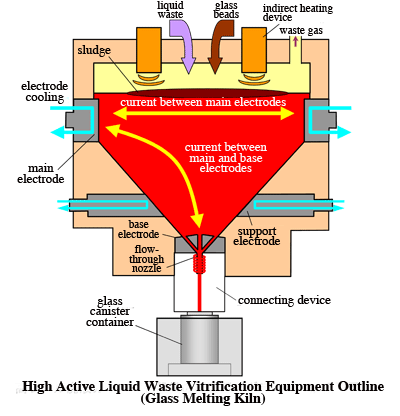Rokkasho Reprocessing Plant Nuke Info Tokyo No. 127
Never Ending Vitrification Problems
The last stage of active testing of the Rokkasho Reprocessing Plant has been plagued by technical problems. The operator, Japan Nuclear Fuel Ltd. (JNFL), has been unable to produce glass canisters to seal the highly radioactive liquid waste left over after reprocessing spent nuclear fuel.
The vitrification process used at Rokkasho involves mixing HLW with borosilicate glass at high temperatures. Testing of the process began in November 2007, but one year later only 104 canisters have been produced. During that time, the facility has only operated for ten weeks in three rounds of tests. Each round of tests has ended in failure.
 Areva’s reprocessing plant in La Hague, France uses the “Atelier de vitrification de Marcoule” (AVM) process. This involves two-stages, using furnaces to evaporate off water and nitric acid and crucibles to melt the mixture. The crucibles, which are small, have an operational life expectancy of about 3,000 hours. By contrast, the “Liquid Fed Ceramic Melter” (LFCM) process employed at Rokkasho is a single stage process. The process, which was developed at Japan’s Tokai Reprocessing Facility, involves putting highly radioactive liquid waste (HLW) and glass beads directly into kilns, where the glass is melted and mixed with the HLW. The 2m x 2m x 2m kilns used at Tokai are much larger than the La Hague crucibles and they are supposed to have a longer life expectancy – in the order of 5 years. The kilns at Rokkasho have been scaled up further to 3m x 3m x 3m. This has compounded the technical problems encountered at Tokai and also given rise to new problems.
Areva’s reprocessing plant in La Hague, France uses the “Atelier de vitrification de Marcoule” (AVM) process. This involves two-stages, using furnaces to evaporate off water and nitric acid and crucibles to melt the mixture. The crucibles, which are small, have an operational life expectancy of about 3,000 hours. By contrast, the “Liquid Fed Ceramic Melter” (LFCM) process employed at Rokkasho is a single stage process. The process, which was developed at Japan’s Tokai Reprocessing Facility, involves putting highly radioactive liquid waste (HLW) and glass beads directly into kilns, where the glass is melted and mixed with the HLW. The 2m x 2m x 2m kilns used at Tokai are much larger than the La Hague crucibles and they are supposed to have a longer life expectancy – in the order of 5 years. The kilns at Rokkasho have been scaled up further to 3m x 3m x 3m. This has compounded the technical problems encountered at Tokai and also given rise to new problems.
Unstable Operational Temperature
The increased size of the kilns at Rokkasho makes temperature control more difficult. It is necessary to maintain the temperature of the kiln at 1,100 ~ 1,200oC while the HLW and the glass are being mixed. However, JNFL has been unable to keep the temperature stable within this range for extended periods of time.
Accumulation of Platinum Group Metals
The unstable temperature gives rise to another problem. It becomes difficult to incorporate platinum group metals (palladium, rhodium, etc.) that are contained in the HLW into the glass matrix. Even at the Tokai facility these elements tended to accumulate at the bottom of the kiln and block the flow of molten glass. Problems arose with the flow of molten glass at the Rokkasho Reprocessing Plant after about 40~60 canisters had been produced. The vitrification process was stopped and JNFL spent over six months trying to fix the problem. The solution it came up with was to add a special rod to stir the glass at the bottom of the kiln. If this failed JNFL planned to remove all the molten glass/HLW mixture from the kiln. However, when the tests recommenced in October (third round of vitrification tests) the window for inserting the mixing rod would not open and the tests had to be stopped at the end of the month. Thus every attempt to solve the problems with the vitrification process gives rise to new problems.
Low Viscosity Fluid
In July (second round of vitrification tests) problems associated with low viscosity fluids (molybdenum, etc.) arose when the kiln was started up and the flow of molten glass stopped. The cause is still being investigated and an adequate solution to the problem has not yet been found.
Doubts are now emerging about the ability of the kilns used at the Rokkasho Reprocessing Plant to maintain stable operation for their design life of five years. At the moment tests are being carried out on kiln A. Tests on kiln B have not even begun. Commercial operation of the Rokkasho Reprocessing Plant cannot commence until both these kilns pass their operational tests. As NIT was going to print, JNFL announced that completion of the tests will be further delayed until February 2009.
Masako Sawai (CNIC)
